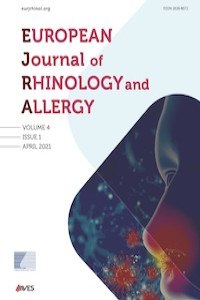Abstract
Objective: We aimed to use middle meatus aspiration technique (MMAT) in both microbiological diagnosis and detection of cytokines and to compare the groups having ARS and non-polyp CRS after determining the microbiological agents and the levels of IL-4, IL-5, IL-13, IL-32, TGF-beta, and thymic stromal lymphopoietin (TSLP).
Material and Methods: The patients were classified as ARS and non-polyp CRS. The microbiological samples were grown on 5% defibrinated sheep blood agar, chocolate agar, Eosin-Methylene Blue agar (EMB), and Sabouraud- dextrose agar (SDA) media. IL-4, IL-5, IL-13 IL-32, TLR2, TSLP, and TGF-beta levels of biochemical samples were studied by ELISA method using commercial kits.
Results: Samples of nasal discharge were collected in a total of 44 patients. The difference between ARS Group and Non-polyp CRS Group regarding the culture growth of pathogens was statistically significant. The levels of TSLP, TGF-beta, IL-4, IL-5, IL-13 and IL-32 were not in conformity with a normal distribution. The differences between ARS Group and Non-polyp CRS Group were not significant regarding these variable.
Conclusion: We have the opinion that, MMAT is a non-invasive method that can be performed at the circumstances of an outpatient clinic and can be used for microbiological diagnosis as well as routine identification of inflammatory processes.
References
- Fokkens WJ, Lund VJ, Mullol J, et al. European position paper on rhinosinusitis and nasal polyps 2012. Rhinol Suppl 2012; 23: 3: 1-298.
- Ren HL, Li JD, Yue FS, Sun JL, Rebeiz EE, Theoharides TC. Nasal cytology with emphasis on mast cells can improve the diagnosis and treatment of chronic rhinosinusitis. Chin Med J 2019; 132: 2237-41.
- Scheckenbach K, Wagenmann M. Cytokine patterns and endotypes in acute and chronic rhinosinusitis. Curr Allergy Asthma Rep 2016; 16: 3.
- Rimmer J, Hellings P, Lund VJ, et al. European position paper on diagnostic tools in rhinol-ogy. Rhinology 2019; 5: 1-41.
- Smith SS, Ference EH, Evans CT, Tan BK, Kern RC, Chandra RK. The prevalence of bacterial infection in acute rhinosinusitis: A Systematic review and meta-analysis. Laryngoscope 2015; 125: 57-69.
- Brook I. Microbiology of chronic rhinosinusitis. Eur J Clin Microbiol Infect Dis 2016; 35: 1059-68.
- Brook I, Frazier EH, Foote PA. Microbiology of the transition from acute to chronic maxil-lary sinusitis. J Med Microbiol 1996; 45: 372-5.
- Jiao J, Wang C, Zhang L. Epithelial physical barrier defects in chronic rhinosinusitis. Expert Rev Clin Immunol 2019; 15: 679-88.
- Georas SN, Rezaee F. Epithelial barrier function: At the front line of asthma immunology and allergic airway inflammation. J Allergy Clin Immunol 2014; 134: 509-20.
- Pistochini A, Rossi F, Gallo S, et al. Multiple gene expression profiling suggests epithelial dysfunction in polypoid chronic rhinosinusitis. Acta Otorhinolaryngol Ital 2019; 39: 169-77.
- Kaya Z, Yayla M, Cinar I, et al. Effect of Montelukast, a Cysteinyl Leukotriene Receptor-1 Antagonist, on a Rat Model of Acute Bacterial Sinonasal Inflammation. Am J Rhinol Allergy 2019; 33: 559-66.
- Kato T, Kouzaki H, Matsumoto K, Hosoi J, Shimizu T. The effect of calprotectin on TSLP and IL-25 production from airway epithelial cells. Allergol Int 2017; 66: 281-9.
- Ying S, O'Connor B, Ratoff J, et al. Thymic stromal lymphopoietin expression is increased in asthmatic airways and correlates with expression of Th2-attracting chemokines and dis-ease severity. J Immunol 2005; 174: 8183-90.
- Nagata Y, Maruoka S, Gon Y, et al. Expression of IL-25, IL-33, and thymic stromallym-phopoietin in nasal polyp gland duct epithelium in patients with chronic rhinosinusitis. Am J Rhinol Allergy 2019; 33: 378-87.
- Dogan M, Sahin M, Yenisey C. Increased TSLP, IL-33, IL-25, IL-19, IL 21 and amphiregu-lin (AREG) levels in chronic rhinosinusitis with nasal polyp. Eur Arch Otorhinolaryngol 2019; 276: 1685-91.
- Kim DK, Kang SI, Kong IG, et al. Two-track medical treatment strategy according to the clinical scoring system for chronic rhinosinusitis. Allergy Asthma Immunol Res 2018; 10: 490-502.
- Milonski J, Zielinska-Blizniewska H, Majsterek I, et al. Expression of POSTN, IL-4, and IL-13 in chronic rhinosinusitis with nasal polyps. DNA Cell Biol 2015; 34: 342-9.
- Baykal Y, Karaayvaz M, Kutlu M. Interleukins. T Clin J Med Sci 1998; 18: 77-83.
- Otto BA, Wenzel SE. The role of cytokines in chronic rhinosinusitis with nasal polyps. Curr Opin Otolaryngol Head Neck Surg 2008; 16: 270-4.
- Kou W, Hu GH, Yao HB, et al. Regulation of transforming growth factor-beta1 activation and expression in the tissue remodeling involved in chronic rhinosinusitis. ORL J Otorhino-laryngol Relat Spec 2012; 74: 172-8.
- Watelet JB, Claeys C, Perez-Novo C, Gevaert P, Van Cauwenberge P, Bachert C. Transforming growth factor beta1 in nasal remodeling: Differences between chronic rhinosi-nusitis and nasal polyposis. Am J Rhinol 2004; 18: 267-72.
- Eloy P, Poirrier AL, De Dorlodot C, Van Zele T, Watelet JB, Bertrand B. Actual concepts in rhinosinusitis: A review of clinical presentations, inflammatory pathways, cytokine profiles, remodeling, and management. Curr Allergy Asthma Rep 2011; 11: 146-62.
Details
| Primary Language | English |
|---|---|
| Subjects | Otorhinolaryngology |
| Journal Section | Original Article |
| Authors | |
| Publication Date | April 1, 2021 |
| Published in Issue | Year 2021 Volume: 4 Issue: 1 |
Cite
You can find the current version of the Instructions to Authors at: https://www.eurjrhinol.org/en/instructions-to-authors-104
Starting on 2020, all content published in the journal is licensed under the Creative Commons Attribution-NonCommercial (CC BY-NC) 4.0 International
License which allows third parties to use the content for non-commercial purposes as long as they give credit to the original work. This license
allows for the content to be shared and adapted for non-commercial purposes, promoting the dissemination and use of the research published in
the journal.
The content published before 2020 was licensed under a traditional copyright, but the archive is still available for free access.

